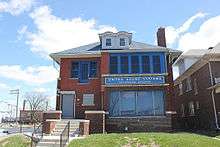United Sound Systems
United Sound Systems is a recording studio and locally designated historic district in Detroit, Michigan, United States.[1] Many popular music artists over the last seventy years have recorded there, including blues musicians like John Lee Hooker (he recorded "Boogie Chillen'" there), and funk bands like Funkadelic. The studio was also the site of the first recording for Berry Gordy's Tamla label in 1959, starting what would become Motown Records. The building is threatened by a planned highway service drive expansion by the Michigan Department of Transportation.[2] The studio ownership changed in 2009 and eventually reopened in 2014.[3] It was designated a local historic district by the City of Detroit in 2015.[4]

Others who have recorded at the studio include Johnnie Ray, Dizzy Gillespie, Jackie Wilson, Dan Schafer and Alberta Adams.[5]
History
There is currently a debate within collector forums and Detroit music historians about the origins of United. The issues revolve around when the first Cass location for the studio began and when it moved to the current location at 5840 Second Avenue.[6] Regardless, it was listed at the current Second Avenue location by 1943.[7]
The historical marker says that James Siracuse converted the current location to a recording studio in 1939. The house it is located in was built in 1916. The 1946 Inter-racial Goodwill Program was recorded here.
In March 2014 the Detroit News reported that:
"M-DOT spokesman Rob Morosi said they [MDOT] met with Scott last summer, and had “a good conversation” about various options on the table. One of those options, he confirms, would be moving the studio from its location on Second at Antoinette. “We’re waiting to hear back from them,” Morosi said Monday. (Scott says she’s exploring her options, but moving the large house and back studio is not what she favors.)"[8]
Later in March, the AP reported that the Detroit City Council "will refer the United Sound Systems Recording Studio matter to a historic designation advisory board for study."[9]
Death
The band called Death first started recording at United Sound Studios on February 18, 1975 after a deal with Don Davis. [10] According to Jennifer Travis, a tour guide at United Sound, the band recorded in studios B and C. [11] The band recorded their first album at United Sound. Unfortunately, during this time period they could not get the radio to play their music. Also, a new sound of disco was emerging and gaining widespread popularity. Both of these obstacles worked against Death gaining an audience and recognition.{11} Although not widely accredited for their innovative sound at first, their rediscovery saw a different reaction by the public. Mike Rubin, a journalist for The New York Times, listed some positive feedback for the band during present times. Celebrated artists such as Jack White from the White Stripes reacted to Death's single saying “The first time the stereo played ‘Politicians in My Eyes,’ I couldn’t believe what I was hearing. When I was told the history of the band and what year they recorded this music, it just didn’t make sense. Ahead of punk, and ahead of their time.” [12] Death significantly contributed to United Sound Systems by introducing their innovative sound. The band members recently visited United Sound in 2013 and signed a petition for the studio to prevent its demolition.{13}
Selected recordings
| Album or song | Artist | Date | US Pop Chart | Notes |
|---|---|---|---|---|
| "Bluebird" and others | Charlie Parker | December 21, 1947 | Recordings for Savoy Records. The group also featured Miles Davis, Duke Jordan, Tommy Potter, and Max Roach.[13] | |
| "Boogie Chillen" | John Lee Hooker | 1948 | ||
| "Come to Me (Marv Johnson song)" | Marv Johnson | Recorded "late 1958"[14] | ||
| "Freakin Out" | Death | 1975 | Group featured David Hackney, Dannis Hackney, and Bobby Hackney | |
| "Sisters Are Doin' It for Themselves" [15] | Eurythmics and Aretha Franklin | 1985 |
References
- Walker, Marlon A. "I-94 expansion threatens recording studio where Motown sound got its start," Detroit Free Press, July 3, 2013.
- Michigan Department of Transportation, "Final Environmental Impact Statement, 2014."
- Hoerler, Eli DiSante. "Detroit's United Sound Systems Studio Slowly Gets Its Groove Back," Deadline Detroit, February 10, 2014
- Lewis, Mathew. "Giving United Sound, Detroit's other landmark music studio, its due". Model D. Model D. Retrieved 23 April 2016.
- historical marker at building
- Maki, Craig. "United Sound Systems: Universal origins?". Retrieved 15 April 2014.
- "Transcription Companies". Billboard Music Year Book 1943. Billboard. Retrieved 15 April 2014.
- Whitall, Susan (March 11, 2014). "Saving United Sound: Legendary Detroit Studio set stave for Motown". Detroit News.
- Associated Press (March 17, 2014). "City seeks historic designation study for Motown studio". Associated Press. Retrieved 15 April 2014.
- A Band Called Death, directed by Mark Covino and Jeff Howlett. Performed by Bobby Hackney, David Hackney, and Dannis Hackney (2013; Detroit: Drafthouse Films 2013.), Amazon.
- Interview with Jennifer Travis. United Sound Recording Studio, December 8, 2014.
- Mike Rubin, "This Band Was Punk Before Punk Was Punk." The New York Times. The New York Times, March 14, 2009, https://www.nytimes.com/2009/03/15/arts/music/15rubi.html?pagewanted=all. (accessed November 18, 2014).
- "Charlie Parker Discography". Jazz Discography Project. Retrieved 15 April 2014.
- Betts, Graham. Motown Encyclopedia. AC Publishing, 2014, pg. 227.
- United Sound Systems » Museum » Detroit's Musical History